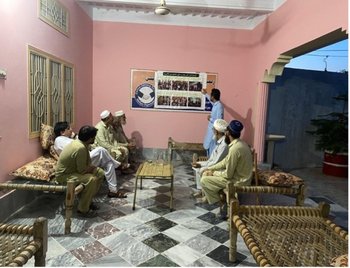Why do humanitarian actors pour resources into a life-improving project, but only to leave the most vital stakeholders – the crisis-affected community – uninformed about its outcomes and impact? This is the question that we explored in our study titled, ‘Making the Results of Humanitarian Evaluation Accessible to Communities: Why It Frequently Fails and What to Do About It.’
In this piece, we explored why this practice of making evaluation results accessible to crisis-affected communities – so widely acknowledge as important – is often not done, what were the barriers, and what are the pockets of good practices to draw on. We also consulted about 40 community members in Pakistan as part of this research, because we wanted to understand what their experiences on this were (if any), and their recommendations for M&E practitioners or researchers who may reach out to them again in the future.
A research about sharing evaluation findings must, of course, live up to what it is advocating to achieve. A month before the report was published, GLOW Consultants in Pakistan, along with NIDA Organization, revisited these communities to share our findings. Whilst research is in many ways different from evaluation (the topic of our study), we wanted to share what we learned and how we applied the methods and insights recommended by the communities themselves in the report. In particular, we reflect here how we used the six actionable steps we put forward in the report – and where we had gaps.
Figure 1: Six steps to ensuring community access to evaluation findings

Asking communities what they prefer
One key question we discussed as a team was how to translate the research findings to make them accessible and useful to communities. We had this question in mind even before the community consultation began. So during data collection, we specifically asked community representatives for their preferences. Our findings show that it’s important to include communities early and often when making findings accessible and useful. This is step one of the six actionable steps.
In our community consultations, we learned that people wanted the findings translated into straightforward, commonly-used local language with clear key messages, alongside pictures or graphic representations. They also suggested considering gender norms by sharing information separately with male and female community members. We also considered gender norms when we conducted the group discussions as suggested by community members themselves during initial consultations – which is step two in the process.
Additionally, community members shared they wanted banners displayed in easily accessible places within the community. They emphasised making the sharing of findings a meaningful conversation, involving the community in discussions about the implications and how they could use the information.
Translating the findings
Our deliberation on the format and translation were informed by these recommendations of the communities. The research findings, including the six actionable steps to improve accessibility, were translated into a simple, easy-to-understand Urdu and complemented with illustrations. This approach, guided by community consultations, ensured the information was understandable and relatable. Banners were hung in community centers and common gathering spots, where members could provide feedback and actively participate in discussions about the findings.
Working with communities to identify the best way to ensure findings are accessible and culturally sensitive is in step three. In some examples we gathered, it shows that this step helps map contextual factors or accessibility barriers at play that need to be considered in adapting the language or format of outputs to make it accessible and engaging.
Creating a space for discussion
Step four, which is about adapting the format and language of the findings in a culturally sensitive manner, considers the unique cultural contexts and values of the community. During our visit, the community appreciated the accessibility of the banners, especially those placed in locations easily reachable by women, in line with gender norms. They also valued the clear translations and illustrations, expressing great satisfaction with how their recommendations were implemented overall.


Creating a space for discussion – which is step five of the six actionable steps – also provided a key insight from communities: sharing of evaluation results should also include the project's expected targets, goals, and outcomes. This would help the community grasp the project's objectives and compare them with actual results, figuring out what's been accomplished and what still needs attention. They also shared that this information could help them think about how they can pitch in to achieve those remaining targets.
Taking it forward
Like many of the M&E practitioners we interviewed, we can relate to the challenges of making evaluation results accessible to communities. Some of those barriers like the lack of resources are very familiar to us. We weren’t able to do step six, the last step yet, which is about letting communities know if and how findings have been utilised and/or resulted in any change.
In sharing our story, we’re hoping that we can come back to community representatives and share how this research they supported inspired change. Our hope is it that it can be used when having conversations with commissioning agencies and evaluation managers on how to plan for making the results of our evaluation and research studies accessible to crisis-affected communities, who as co-creators of knowledge, should be informed of the outcomes of their contributions.


